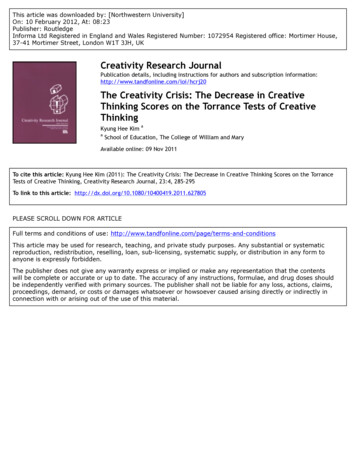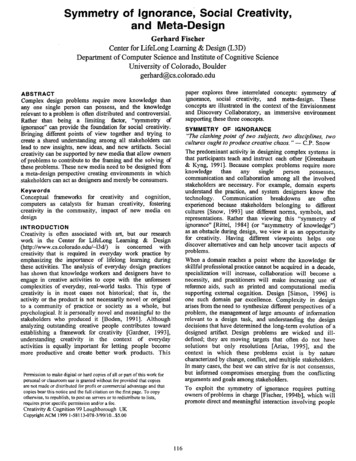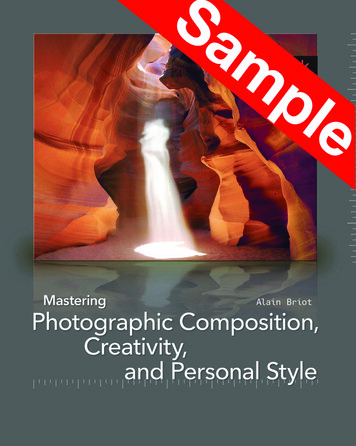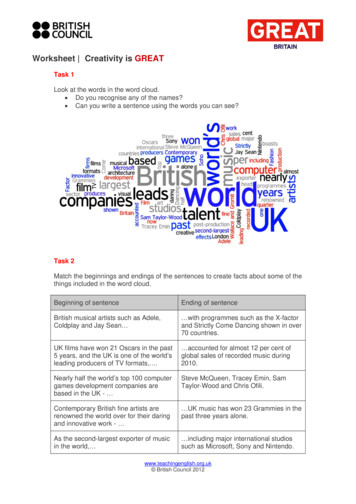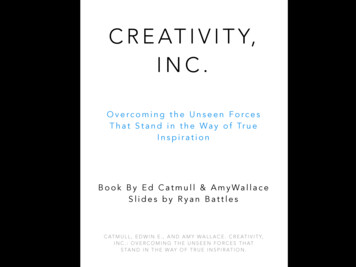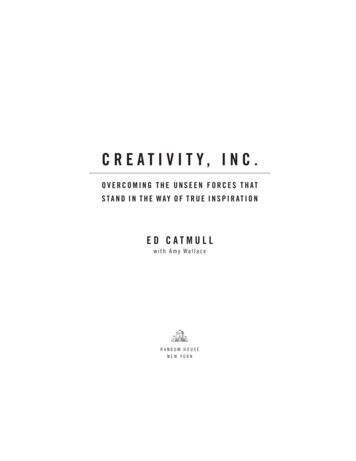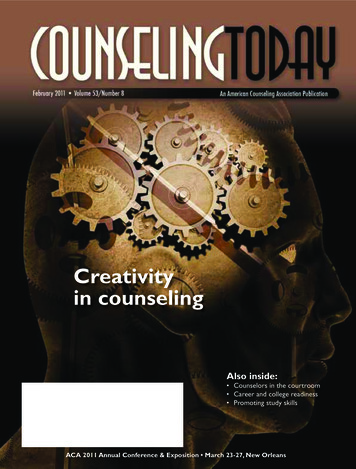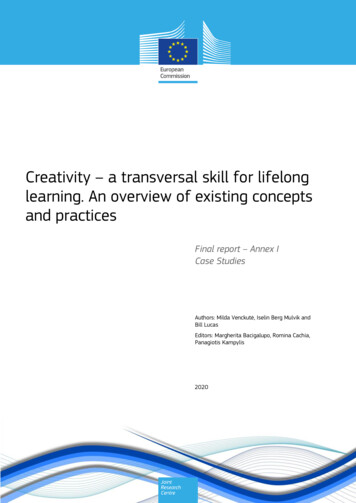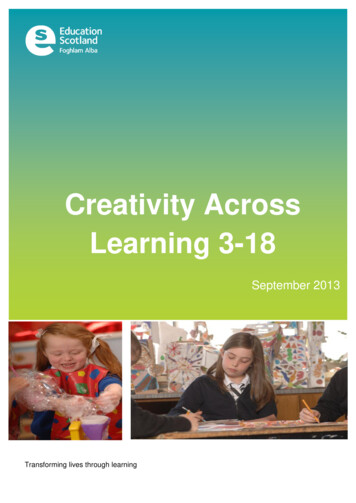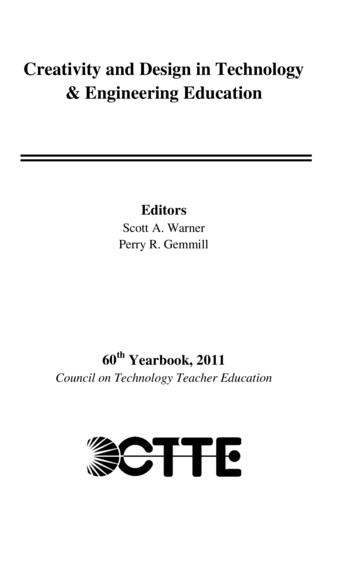
Transcription
Creativity and Design in Technology& Engineering EducationEditorsScott A. WarnerPerry R. Gemmill60th Yearbook, 2011Council on Technology Teacher Education
Copyright 2011 by the Council on Technology Teacher Education.All rights reserved. No part of this publication may be reproduced ordistributed in any form or by any means, or stored in a database orretrieval system, without the prior written consent of the Council onTechnology Teacher Education, including, but not limited to, networkstorage or transmission, or broadcast for distance learning.Council on Technology Teacher Education1914 Association DriveSuite 201Reston, VA 20191-1539ISBN-13: 978-1-887101-10-3Printed in the United States of America.1 2 3 4 5 6 7 8 9 10 044 11 10 09 08 07This publication is available in microfilm from:UMI300 North Zeeb RoadDept. P.R.Ann Arbor, MI 48106-ii-
FOREWORDCreativity is a great motivator because it makes people interested in what theyare doing. Creativity gives hope that there can be a worthwhile idea. Creativitygives the possibility of some sort of achievement to everyone. Creativity makeslife more fun and more interesting. Edward de BonoThe annual Council on Technology Teacher Education (CTTE) yearbook seriesshowcases important happenings and trends in the field of technology education. Eachyearbook is written by professionals who are passionate about advancing knowledge,research, and skills in the field of technology education and the emerging field of K12 engineering education. This tradition of excellence continues and the CTTE isproud to present its 60th yearbook that focuses on concepts related to Creativity andDesign in Technology & Engineering Education.Creativity and design are important in technology education. Creativity involves“thinking outside the box” and it helps to foster many of today’s new innovations andinventions. Design is a problem solving process and often requires using creativethinking to help solve problems and extend human capabilities. This yearbookprovides an in-depth review of creativity and design in technology education andexplores many important related concepts.The 60th yearbook begins by setting the context for creativity and design intechnology education and defines their meaning. The first section of chapters focuseson creativity. They examine the many forms of creativity. The second section ofchapters focuses on concepts related to the developmental stages of humans andcreativity, the human brain as the source of creativity, as well as creativity,innovation, and design thinking. The third section of chapters examines pedagogy andenvironments for creativity and design; specifically, matters related to knowledge andskills as well as the physical and cultural environments for creativity and design arediscussed. This section also focuses on the importance of developing curriculum,instruction, and assessment for creativity and design. The final section of theyearbook looks at the importance of professional development. The yearbookconcludes with a conceptual model and future perspectives for using and enhancingcreativity and design within technology and engineering education.The editors, Drs. Scott Warner and Perry Gemmill, and their chapter authors haveworked diligently in developing this timely publication and should be commended fortheir efforts. I would be remiss if I did not call special attention to one of the authors,Gerald F. Day, who passed away shortly after completing his chapter. He was aconsummate professional in the field of technology education.On behalf of the Council and the Yearbook Committee, we are honored topresent this publication to the profession. I know you will enjoy reading and learningabout the many aspects related to creativity and design in technology education and itsimportance to developing dynamic and progressive technology and engineeringeducation curricula.Edward M. ReevePresident, CTTEJune 2011-iii-
YEARBOOK PLANNING COMMITTEEChairpersonRichard D. SeymourBall State UniversityTerms Expiring in 2011Philip A. ReedOld Dominion UniversityBrian McAlisterUniversity of Wisconsin-StoutTerms Expiring in 2012Marie HoepflAppalachian State UniversityChris MerrillIllinois State UniversityTerms Expiring in 2013Joshua BrownIllinois State UniversityJenny DaughertyPurdue UniversityTerms Expiring in 2014Ryan BrownIllinois State UniversityRichard SeymourBall State University-iv-
OFFICERS OF THE COUNCILPresidentEdward M. ReeveUtah State UniversityDepartment of Engineering and Technology EducationLogan, Utah 84322-600Vice-PresidentRyan BrownIllinois State UniversityCollege of EducationNormal, Illinois 61790-5100SecretaryMichael GrubbsAdamson Middle School3187 Rex RoadRex, Georgia 30273TreasurerPetros KatsioloudisOld Dominion UniversitySTEM Education and Professional StudiesNorfolk, Virginia 23529Past PresidentRichard D. SeymourBall State UniversityDepartment of TechnologyMuncie, IN 47306-0255-v-
YEARBOOK PROPOSALSEach year at the ITEEA International Conference, the CTTE YearbookCommittee reviews the progress of yearbooks in preparation and evaluatesproposals for additional yearbooks. Any member is welcome to submit ayearbook proposal, which should be written in sufficient detail for thecommittee to be able to understand the proposed substance and format. Fifteencopies of the proposal should be sent to the committee chairperson by February1 of the year in which the conference is held. Below are the criteria employedby the committee in making yearbook selections.CTTE Yearbook CommitteeCTTE Yearbook GuidelinesA. PurposeThe CTTE Yearbook Series is intended as a vehicle for communicatingmajor topics or issues related to technology teacher education in astructured, formal series that does not duplicate commercial textbookpublishing activities.B. Yearbook topic selection criteriaAn appropriate yearbook topic should:1. Make a direct contribution to the understanding and improvement oftechnology teacher education;2. Add to the accumulated body of knowledge of technology teachereducation and to the field of technology education;3. Not duplicate publishing activities of other professional groups;4. Provide a balanced view of the theme and not promote a singleindividual’s or institution’s philosophy or practices;5. Actively seek to upgrade and modernize professional practice intechnology teacher education; and,6. Lend itself to team authorship as opposed to single authorship.Proper yearbook themes related to technology teacher education may alsobe structured to:1. Discuss and critique points of view that have gained a degree ofacceptance by the profession;2. Raise controversial questions in an effort to obtain a national hearing;and,3. Consider and evaluate a variety of seemingly conflicting trends andstatements emanating from several sources.C. The Yearbook Proposal1. The yearbook proposal should provide adequate detail for theYearbook Committee to evaluate its merits.2. The yearbook proposal includes the following elements:-vi-
a) Defines and describes the topic of the yearbook;b) Identifies the theme and describes the rationale for the theme;c) Identifies the need for the yearbook and the potential audience oraudiences;d) Explains how the yearbook will advance the technology teachereducation profession and technology education in general;e) Diagram symbolically the intent of the yearbook;f) Provides an outline of the yearbook which includes:i) A table of contents;ii) A brief description of the content or purpose of each chapter;iii) At least a three level outline for each chapter;iv) Identification of chapter authors (s) and backup authors;v) An estimated number of pages for each yearbook chapter; and,vi) An estimated number of pages for the yearbook (not to exceed250 pages).g) Provides a timeline for completing the yearbook.It is understood that each author of a yearbook chapter will sign a CTTEEditor/Author Agreement and comply with the Agreement. Additionalinformation on yearbook proposals is found on the CTTE web site athttp://www.ctete.org/-vii-
PREVIOUSLY PUBLISHED YEARBOOKS*1. Inventory Analysis of Industrial Arts Teacher Education Facilities, Personnel andPrograms, 1952.*2. Who’s Who in Industrial Arts Teacher Education, 1953.*3. Some Components of Current Leadership: Techniques of Selection and Guidanceof Graduate Students; An Analysis of Textbook Emphases; 1954, three studies.*4. Superior Practices in Industrial Arts Teacher Education, 1955.*5. Problems and Issues in Industrial Arts Teacher Education, 1956.*6. A Sourcebook of Reading in Education for Use in Industrial Arts and IndustrialArts Teacher Education, 1957.*7. The Accreditation of Industrial Arts Teacher Education, 1958.*8. Planning Industrial Arts Facilities, 1959. Ralph K. Nair, ed.*9. Research in Industrial Arts Education, 1960. Raymond Van Tassel, ed.*10. Graduate Study in Industrial Arts, 1961. R.P. Norman and R.C. Bohn, eds.*11. Essentials of Preservice Preparation, 1962. Donald G. Lux, ed.*12. Action and Thought in Industrial Arts Education, 1963. E.A.T.Svendsen, ed.*13. Classroom Research in Industrial Arts, 1964. Charles B. Porter, ed.*14. Approaches and Procedures in Industrial Arts, 1965. G.S. Wall, ed.*15. Status of Research in Industrial Arts, 1966. John D. Rowlett, ed.*16. Evaluation Guidelines for Contemporary Industrial Arts Programs, 1967. LloydP. Nelson and William T. Sargent, eds.*17. A Historical Perspective of Industry, 1968, Joseph F. Luetkemeyer Jr., ed.*18. Industrial Technology Education, 1969. C. Thomas Dean and N.A. Hauer, eds.;Who’s Who in Industrial Arts Teacher Education, 1969. John M. Pollock andCharles A. Bunten, eds.*19. Industrial Arts for Disadvataged Youth, 1970. Ralph O. Gallington, ed.*20. Components of Teacher Education, 1971. W.E. Ray and J. Streichler, eds.*21. Industrial Arts for the Early Adolescent, 1972. Daniel J. Householder, ed.*22. Industrial Arts in Senior High Schools, 1973. Rutherford E. Lockette, ed.*23. Industrial Arts for the Elementary School, 1974. Robert G. Thrower and RobertD. Weber, eds.*24. A Guide to the Planning of Industrial Arts Facilities, 1975. D.E. Moon, ed.*25. Future Alternatives for Industrial Arts, 1976. Lee H. Smalley, ed.*26. Competency-Based Industrial Arts Teacher Education, 1977. Jack C. Brueckmanand Stanley E. Brooks, eds.*27. Industrial Arts in the Open Access Curriculum, 1978. L.D. Anderson, ed.*28. Industrial Arts Education: Retrospect, Prospect, 1979. G. Eugene Martin, ed.*29. Technology and Society: Interfaces with Industrial Arts, 1980. Herbert A.Anderson and M. James Benson, eds.*30. An Interpretive History of Industrial Arts, 1981. Richard Barella and ThomasWright, eds.*31. The Contributions of Industrial Arts to Selected Areas of Education, 1982. DonaldMaley and Kendall N. Starkweather, eds.*32. The Dynamics of Creative Leadership for Industrial Arts Education, 1983. RobertE. Wenig and John I. Mathews, eds.*33. Affective Learning in Industrial Arts, 1984. Gerald L. Jennings, ed.-viii-
*34. Perceptual and Psychomotor Learning in Industrial Arts Education, 1985. JohnM. Shemick, ed.*35. Implementing Technology Education, 1986. Ronald E. Jones and John R.Wright, eds.*36. Conducting Technical Research, 1987. Everett N. Israel and R. Thomas Wright,eds.*37. Instructional Strategies for Technology Education, 1988. William H. Kemp andAnthony E. Schwaller, eds.*38. Technology Student Organizations, 1989. M. Roger Betts and Arvid W. VanDyke, eds.*39. Communication in Technology Education, 1990. Jane A. Liedtke, ed.*40. Technological Literacy, 1991. Michael J. Dyrenfurth and Michael R. Kozak, eds.*41. Transportation in Technology Education, 1992. John R. Wright and StanleyKomacek, eds.*42. Manufacturing in Technology Education, 1993. Richard D. Seymour and Ray L.Shackelford, eds.*43. Construction in Technology Education, 1994. Jack W. Wescott and Richard M.Henak, eds.*44. Foundations of Technology Education, 1995. G. Eugene Martin, ed.*45. Technology and the Quality of Life, 1996. Rodney L. Custer and A. EmersonWiens, eds.46. Elementary School Technology Education, 1997. James J. Kirkwood and PatrickN. Foster, eds.47. Diversity in Technology Education, 1998. Betty L. Rider, ed.48. Advancing Professionalism in Technology Education, 1999. Anthony F. Gilbertiand David L. Rouch, eds.*49. Technology Education for the 21st Century: A Collection of Essays, 2000. G.Eugene Martin, ed.*50. Appropriate Technology for Sustainable Living, 2001, Robert C. Wicklein.51. Standards for Technological Literacy: The Role of Teacher Education, 2002.John M. Ritz, William E. Dugger, and Everett N. Israel, eds.52. Selecting Instructional Strategies for Technology Education, 2003. Kurt R.Helgeson and Anthony E. Schwaller, eds.53. Ethics for Citizenship in a Technological World, 2004. Roger B. Hill, ed.54. Distance and Distributed Learning Environments: Perspectives and Strategies,2005. William L. Havice and Pamela A. Havice, eds.55. International Technology Teacher Education, 2006. P. John Williams, ed.56. Assessment of Technology Education, 2007. Marie C. Hoepfl and Michael R.Lindstrom, eds.57. Engineering and Technology Education, 2008. Rodney L. Custer and Thomas L.Erekson, eds.58. Essential Topics for Technology Educators. CTTE Yearbook PlanningCommittee, eds.59. Research in Technology Education, 2010. Phil Reed and Jim LaPorte, eds.*Out-of-print yearbooks can be obtained in microfilm and in Xerox copies. Forinformation on price and delivery, write to UMI, 300 North Zeeb Road, Dept. P.R., AnnArbor, Michigan 48106.-ix-
PREFACECreativity has been associated with the peak experiences in one’slife. Giving birth to new ideas, relationships, and objects usuallyrequires effort, perseverance, and know-how. Creative people areintrinsically motivated and rewarded with the joy that they receive frombeing engaged in design processes and the resultant outcomes.Creativity and design has been a global fundamental theme oftechnology education for over
Richard Barella and Thomas Wright, eds. *31. The Contributions of Industrial Arts to Selected Areas of Education, 1982. Donald Maley and Kendall N. Starkweather, eds. *32. The Dynamics of Creative Leadership for Industrial Arts Education, 1983. Robert E. Wenig and John I. Mathews, eds. *33. Affective Learning in Industrial Arts, 1984. Gerald L. Jennings, ed. -ix-*34. Perceptual and Psychomotor .
